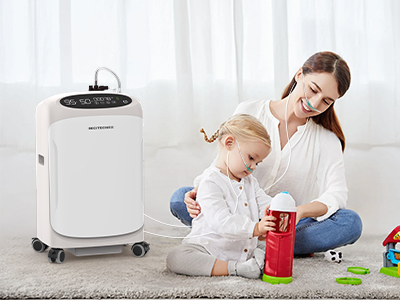25 Apr 2025
Oxygen therapy When it comes to oxygen therapy at home, safe planning for each room is necessary to help patients feel confident and comfortable.

Living Room: Comfort Meets Caution
The living room often serves as command central—a place for relaxation, family gatherings, and, for many, hours of oxygen therapy use. But within these cozy confines lurk several fire risks. Open flames—candles, fireplaces, or even incense—must be completely avoided in any space where oxygen is present. Likewise, smokers should be politely exiled to distant outdoor corners of the property.
Electrical devices like televisions, charging ports, and lamps should be spaced generously apart from oxygen tubing and concentrators to prevent overheating or sparking. Furniture should be arranged with a mind toward maneuverability—no labyrinths of chairs and coffee tables that might tangle tubes or trip feet. Oxygen and comfort can coexist. They just need boundaries.
Kitchen: Where Heat and Oxygen Don't Mix
Kitchens are sanctuaries of flavor—and zones of combustible chaos. With stovetops, toasters, ovens, and the occasional flambé, the kitchen demands heightened vigilance for oxygen users. Never cook while wearing a nasal cannula. It’s a spark away from disaster. Instead, prepare food with the oxygen source kept several feet away, and ideally, turn off the flow momentarily if medically feasible.
Ensure excellent ventilation. Extractor fans, open windows, and a strategic fan can help dissipate ambient oxygen buildup. Store oxygen cylinders far from heat sources and make sure cords are kept clear of pathways and sharp cabinet edges. In the kitchen, prevention is always on the menu.
Bedroom: Restful Nights with Rigorous Safety
Sleep is sacred. But so is fire safety. Bedrooms must be meticulously prepared for overnight oxygen therapy. First, ensure the concentrator or cylinder is placed at least 6 feet from the bed—particularly from pillows and comforters, which can generate static electricity. Avoid wool or synthetic bedding that holds onto sparks like secrets.
Grounded outlets are a must. Surge protectors help, but never plug oxygen machines into power strips shared with other devices. And always keep the floor clear of oxygen tubing to prevent midnight tumbles. A safe bedroom is a serene one—and nothing beats uninterrupted slumber on a secure foundation.
Bathroom: Moisture, Mirrors, and Mishaps
Bathrooms are slippery domains of steam and electricity—a combination that calls for strict oxygen protocol. Never place a concentrator in the bathroom. Moisture seeps into its mechanical guts and corrodes components like a slow-moving enemy. Instead, position it just outside the door, and run tubing in through a small gap.
Keep all outlets and power cords away from sinks and tubs. Add non-slip mats and grab bars to reduce fall risk, especially if oxygen tubing trails behind. And remember: no aerosols, hairsprays, or alcohol-based products near oxygen—they’re flammable invaders in an already precarious environment.

Home Office or Work Area: Productivity Without Peril
Work-from-home warriors often juggle monitors, modems, mugs, and machinery in tight quarters. Oxygen concentrators must be stationed far from paper stacks, electronics, and tangled cords that could cause a spark—or a fall. Cables should be secured to the wall or bundled safely to avoid tripping hazards.
Air purity is paramount. No vaping, no incense, no “just one quick cigarette by the window.” Oxygen saturation can linger in fabric and air, turning even a brief smoke into a ticking time bomb. And keep a fire extinguisher handy, just in case productivity ever ignites more than ideas.
Hallways and Stairs: The Arteries of Safe Navigation
Hallways are lifelines between rooms—and trip wires if you’re not careful. Secure oxygen tubing with clips or specialized floor runners. Hallway nightlights are small investments that pay dividends in visibility, especially for nighttime movement.
For homes with stairs, portable concentrators are game-changers, freeing patients from the tyranny of stationary systems. Install handrails, stair treads, and oxygen tube hooks to maintain order on the ascent. When mobility is safe, freedom follows.
Garage or Workshop: Tools, Toxins, and Oxygen Don't Mix
Workshops and garages are great for tinkering. But they’re also havens for volatile substances like gasoline, paint thinner, and propane. These are strictly incompatible with oxygen therapy. Any open oxygen source should be banned from areas where fumes or combustibles are stored.
Power tools, welding gear, and battery chargers can all produce sparks. Keep concentrators and cylinders at a safe distance—or, better yet, out of the garage entirely. If storage is necessary, use a climate-controlled area and mount cylinders upright and secured, far from any ignition source.
Outdoor Spaces: Breathing Easy Under the Sky
Fresh air is therapeutic—but nature brings its own complications. When using oxygen outside, avoid direct sunlight on the equipment, which can cause overheating. Keep tubing away from bushes, dogs, and toddlers—three of nature’s most curious creatures.
Portable concentrators are ideal for outings, offering mobility without the bulk. Protect them from rain and dust with weather-resistant covers. And if there’s a grill or fire pit nearby, oxygen users should admire from afar. No backyard BBQ is worth the risk of combustion.
Conclusion: Whole-Home Harmony for Oxygen Users
Room-by-room safety planning isn’t an exercise in paranoia—it’s an investment in freedom. When each space is optimized for oxygen therapy, patients can live confidently and comfortably, surrounded not by hazards but by thoughtful design.
Keywords: oxygen therapy
Originally published 25 Apr 2025, updated 25 Apr 2025.